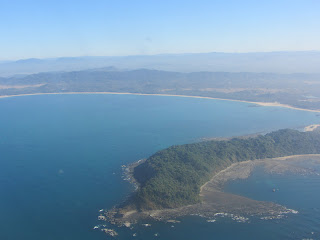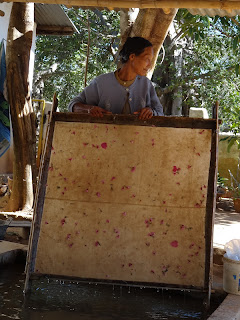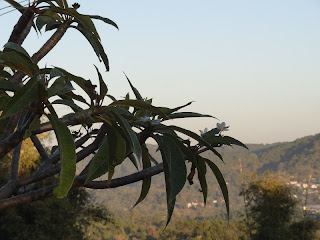Jan 15 – 17 Bago
Today Udo and I are
separating as well. He is determined to visit Ngapali Beach to see
how an 'untouched' beach in Myanmar looks like. I don't feel like
shelling out for the expensive airfare and am opting for the bus
instead and will stop in Bago, en route back to Yangon where our
flight is leaving on January 17th.
Udo leaves early morning.
My bus is scheduled to leave at 1pm from the 'highway' junction
outside Nyaungshwe and get to Bago at 3am. So I have prebooked
accommodation there. 3am after all is not a great time to be
strolling around looking for a place to stay.
I leave on time, hop on a
pick-up truck to the junction and wait and wait and wait. Around 3pm
I receive a call informing me that my bus is late. Nice for them to
be telling me that, but I already assumed, considering that I've been
waiting for nearly three hours. Another 45 minutes later and old run
down Korean bus finally arrives and unfortunately this one is mine.
By now I am just happy to be leaving, but not so fast. The bus breaks
down a little later on the mountain roads. Gets fixed within an hour
and off we are again. At the rest stop I do buy some locally made
Myanmar wine. Considering I would need that if the trip continues
that way. A horrible bus ride later (seriously, if you can afford it,
fly to and from Inle, the mountain roads will take their toll on you
and your vacation) I get into Bago near 6am, pitch dark, hitch a
cyclo cab to the guesthouse and nap for a little while.
 |
| Saying goodbye to Mama Susu |
 |
| Luxurious Myanmar toilet |
 |
| Stocking up on some Kalaw wine |
Since I only have one day
in Bago and apparently there's plenty to see no time to be wasted. I
set out at 10am with a motorcycle driver. After agreeing to pay him
10$ he agrees to go around to back entries of all the major sights so
I do not have to pay the 10$ entrance fee. Gotta love that system ;-)
We visit the local
monastery in which several hundred monks are being educated. The big
show for the tourists is the feeding of the monks (whaaaat?!?!). As
usual, since I am already here I might as well watch it. First my
driver leads me around, tells me about his life (10 days) of being a
monk, shows me the kitchen and sleeping quarters (all very basic).
And here it is. The big 'show'. At 11am, since monks are required to eat all their daily meals before noon. Hundreds of monks line up, food bowls in hand and head toward the dining hall once the huge Gong has sounded. Tourists (many Buddhist Thais) line up before the entrance of the dining hall and against donations get to sweep up rice and 'donate' it to the Monks before they enter the dining hall. After they all entered you can watch them eat their rice and fish and meat curries. The menu is the exact same every day. Rice and curry. Rice and curry. My driver admits he was tired of it after a few days, the monks in this monastery however agree to the lifestyle for many years.
Our tour of religious
artifacts in Bago starts. And there's plenty of them. Pagodas,
temples, Buddhas. And by this time you've seen plenty of pictures of
them as well I will leave the detailed explanations out. Just to say
I did not pay entrance fees and also did not pay the camera fees
demanded at most sites. After all do you really want to see more
close ups of the religious sights? It's been enough for you too?
That's exactly what I thought. So after visiting the biggest Pagoda
in Myanmar (bigger than Shewdagon in Yangon), the Pagoda which offers
a great view of Bago and a temple famous for a snake (I didn't quite
understand the full story) I also get to experience a cigar factory.
Women rolling up the tobacco mixed with other stuff in leaves and
expertly trimming it to look like a professional cigar/cigarette.
Apparently they are quite light, but I've had enough from trying the
one in Bagan. Yikes. The working conditions would seem crazy in our
part of the world but the women hear seem content, joking in between,
eating and smiling (or curiously staring at the foreigner – me).
At this point I was
actually hoping that the tour would be finished, is there really so
much to see in Bago. But no, we've only seen one side of the river.
After lunch break we will see the other part.
Curiosity wins over
tiredness and after exploring the Bago market I am ready to be shown
some more. The some more is more Pagodas and more Buddhas. I wish I
could ask my Moto driver if there is anything to see in Bago that
doesn't involve Buddhas but he is so proud of them and showing them
off I don't dare say anything. So hear I go to the Stupa with the 30
something Buddhas, the 80something sitting Buddhas, the standing
Buddhas. The giant reclining Buddhas. And yes, the reclining Buddhas
are impressive. The Stupa with 80something Buddhas inside, the
biggest reclining Buddha in the world (real intricate details on that
one). By the time we reach the 4 giant sitting Buddhas I am totally
Buddha'd out.
I love Myanmar and it is
beautiful. But for now I am grateful I am leaving Buddha central. For
a little while I want to stay clear of more monuments to religion.
I relax for the rest of
the evening and morning.
Apparently I need two
hours from Bago to Yangon, another 20 minutes or so to the bus
station in Bago and another half hour or so from Yangon bus station
to the airport, all provided I get immediate buses and onward
transport. Since they are hopelessly overcharging for scheduled buses
that come once in a blue moon I do what was recommended, just head to
a highway stop on a moto taxi for 500K. I leave early enough to have
plenty of time to catch the flight should anything be delayed or go
wrong (just think of the last bus rides). Against my expectation
everything goes smooth. The bus to Yangon is empty when I get there
but fills up within a matter of minutes. It's the one of the sort
that should have broken down already long ago, but still sputters
along. For a short ride, of far less than the planned two hours, that
is fine (and only 1000K). And I have an old guy in front of me that
loves to practice his English and also chitchat about the local
situation, including politics. While everyone I met hates the
government they all admit as well it has been getting better in the
past months and people are hopeful.
The transition to the
airport is smooth as well for a hard negotiated 1500K (considering
Mag paid 6000K three days earlier for a spot in a full taxi) I get my
own cab to the airport and am there in a few minutes. About five
hours before my scheduled departure. Nooooooo!
Killing some time until
Udo joins me in the wait. He loved Ngapali and enjoyed his beach time
loads. We also run into Nino again, so the hours pass quickly with
sharing stories.
Myanmar is definitely
worth the trip. It takes more planning than a trip to most other
countries but richly rewards the person taking the effort. Challenges
will be plenty, especially if you would like to venture off the
tourist paths that require permits or would like to visit areas that
can only be reached (by foreigners) by air with flights that are not
readily scheduled but just happen when they happen. But nothing that
can't be taken care of with lots of patience and a smile.
It is a very safe
country. While they see any single traveler as weird they are most
likely to help you. All the money you bring is safe as well, just
keep your wits and street smarts on.
Put Myanmar on your
travel list now, before everyone else catches on and Bagan is as
overrun as Angkor Wat, Bago sees the hordes of Wat Pho, Bangkok, the
developers pave over Inle Lake and Ngapali is the next Phuket.



































































